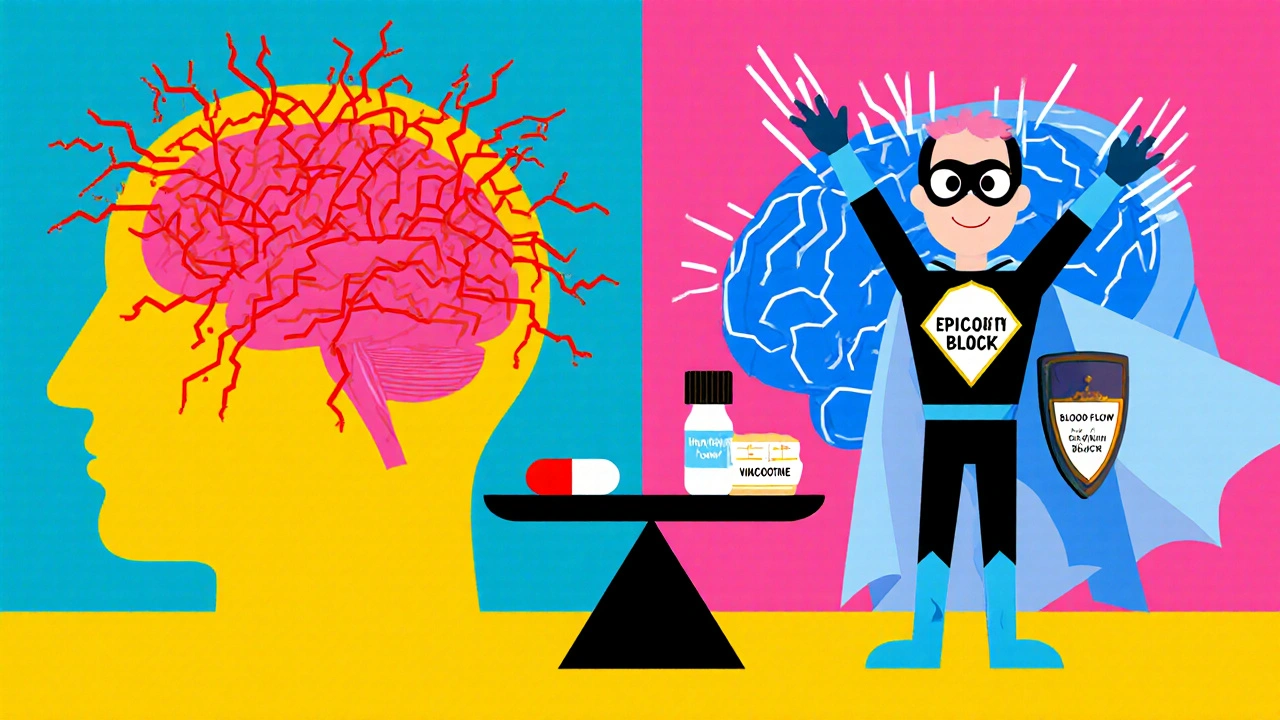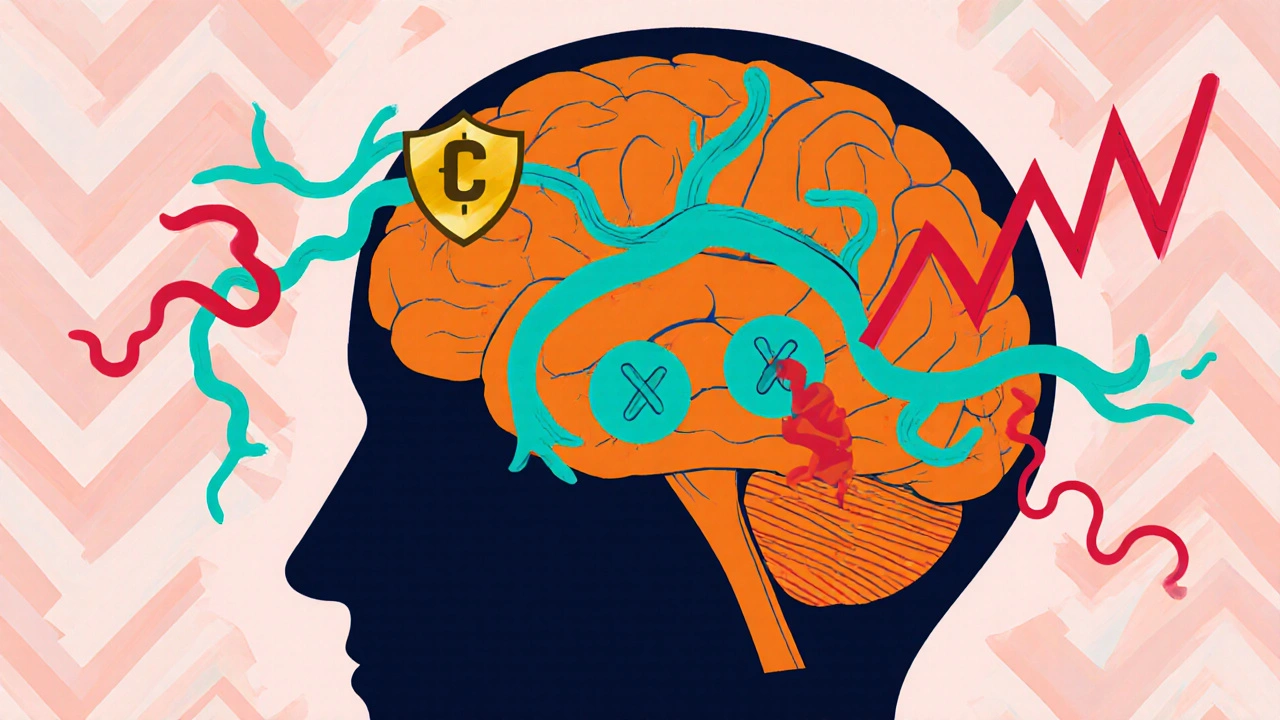For people living with epilepsy, finding ways to reduce seizure frequency isn’t just about convenience-it’s about safety, independence, and quality of life. While medications like levetiracetam or valproate are the standard, many people explore supplements to support their treatment. One of them is vinpocetine. But does it actually help? And if so, how?
What Is Vinpocetine?
Vinpocetine is a synthetic compound derived from vincamine, a natural alkaloid found in the periwinkle plant. It’s been used for decades in Europe and Asia as a nootropic and cerebral blood flow enhancer. In countries like Germany and Japan, it’s approved as a prescription drug for cognitive decline and post-stroke recovery. In the U.S., it’s sold as a dietary supplement.
Its main actions in the brain include improving blood circulation, increasing oxygen and glucose delivery to brain cells, and reducing inflammation. It also blocks sodium and calcium channels, which helps calm overactive neurons. That last part is key-because seizures happen when too many neurons fire at once.
How Epilepsy Works
Epilepsy isn’t one disease. It’s a group of disorders where abnormal electrical activity in the brain causes recurrent seizures. These can range from brief staring spells to full-body convulsions. The cause varies: genetic mutations, brain injuries, infections, tumors, or sometimes nothing clear at all.
Current treatments focus on suppressing that abnormal electrical activity. Antiseizure drugs do this by targeting ion channels, neurotransmitters, or synaptic transmission. But they don’t work for everyone. About 30% of people with epilepsy have drug-resistant seizures. That’s why people look for alternatives-like vinpocetine.
How Vinpocetine Might Help Reduce Seizures
The science behind vinpocetine and epilepsy is still emerging, but several mechanisms suggest it could play a supportive role:
- Improved cerebral blood flow: Many epilepsy patients have reduced blood flow in affected brain regions. Vinpocetine dilates blood vessels in the brain, helping deliver more oxygen and nutrients where they’re needed most.
- Neuroprotection: Seizures damage brain cells over time. Vinpocetine reduces oxidative stress and inflammation, protecting neurons from this damage.
- Calcium channel modulation: Excess calcium entering neurons triggers hyperexcitability. Vinpocetine blocks voltage-dependent sodium and calcium channels, making neurons less likely to fire uncontrollably.
- GABA enhancement: Some animal studies show vinpocetine increases GABA levels-the brain’s main calming neurotransmitter. Low GABA is linked to seizure susceptibility.
A 2018 study published in Neurochemical Research tested vinpocetine in rats with chemically induced seizures. The rats given vinpocetine had significantly fewer seizures and longer intervals between them. The researchers concluded it had a clear anticonvulsant effect, likely due to its action on ion channels and neuroprotection.
Human data is limited but promising. A small 2021 pilot study in Turkey followed 24 adults with drug-resistant epilepsy who added 10 mg of vinpocetine daily to their existing meds. After three months, 63% reported fewer seizures. Five patients had a 50% or greater reduction. No serious side effects were reported.
How to Use Vinpocetine for Epilepsy
If you’re considering vinpocetine, here’s what you need to know:
- Dosage: Most studies use 10-30 mg per day, split into two or three doses. Start low-10 mg daily-to see how your body responds.
- Timing: Take it with food to improve absorption. Many people take it in the morning and early afternoon to avoid potential sleep disruption.
- Duration: Effects may take 4-8 weeks to become noticeable. Don’t expect immediate results.
- Form: Look for capsules or tablets with 10 mg per dose. Avoid powdered forms unless you’re experienced with supplement dosing.
It’s critical to understand: vinpocetine is not a replacement for prescribed antiseizure medication. It’s a potential add-on. Stopping your current meds without medical supervision can be dangerous.
Who Should Avoid Vinpocetine?
Not everyone should take it. Avoid vinpocetine if you:
- Have a bleeding disorder or are on blood thinners (like warfarin or aspirin)-vinpocetine can increase bleeding risk.
- Are pregnant or breastfeeding-there’s not enough safety data.
- Have low blood pressure-it can lower it further.
- Are allergic to plants in the Apocynaceae family (like periwinkle).
Also, talk to your neurologist before starting. Some antiseizure drugs interact with supplements. Your doctor might need to adjust your dosage or monitor your blood levels more closely.
Real-Life Experience: What People Report
Online forums and patient groups are full of stories. Sarah, 38, from Ohio, started vinpocetine after her seizures increased despite being on three medications. She took 15 mg daily and noticed her aura (the warning sign before her seizure) became less intense. Over six months, her monthly seizures dropped from 8 to 3.
James, 52, had temporal lobe epilepsy and struggled with memory fog. He added vinpocetine and noticed his brain felt clearer-not just fewer seizures, but better focus during the day.
These aren’t clinical trials. But they show a pattern: people who respond often report fewer seizures, less post-seizure fatigue, and better mental clarity.
What Doesn’t Work
Vinpocetine isn’t magic. It won’t work for everyone. Some people report no change at all. Others feel dizzy or get mild headaches at first. That usually passes in a few days.
It also won’t fix underlying causes like a brain tumor or genetic mutation. It’s not a cure-it’s a tool. And it works best when combined with good sleep, stress management, and consistent medication.
How It Compares to Other Supplements
People often ask: how does vinpocetine stack up against other supplements for epilepsy?
| Supplement | Primary Mechanism | Dosage | Evidence Level | Key Risks |
|---|---|---|---|---|
| Vinpocetine | Improves blood flow, blocks calcium channels | 10-30 mg/day | Moderate (animal studies + small human trials) | Bleeding risk, low BP |
| Magnesium | Stabilizes neuronal membranes | 200-400 mg/day | Strong (multiple RCTs) | Diarrhea, kidney issues |
| Omega-3 (EPA/DHA) | Reduces brain inflammation | 1,000-2,000 mg/day | Moderate (mixed results) | Blood thinning |
| Ketogenic Diet | Shifts brain energy source to ketones | Dietary change | Very strong (gold standard for drug-resistant cases) | Difficult to maintain, nutrient gaps |
| CBD (Cannabidiol) | Modulates endocannabinoid system | 5-20 mg/kg/day | Strong (FDA-approved for two epilepsy syndromes) | Liver enzyme changes, drug interactions |
Vinpocetine doesn’t have the same level of proof as CBD or the ketogenic diet. But it’s easier to use, cheaper, and has fewer side effects than many prescription drugs. For people who’ve tried everything else, it’s worth a cautious trial.

What to Expect When You Start
If you decide to try vinpocetine, keep a seizure journal. Record:
- Date and time of each seizure
- Duration and type
- Any triggers (stress, sleep loss, flashing lights)
- Dosage and time you took vinpocetine
- Side effects (headache, dizziness, nausea)
Review it every 30 days. Look for trends: Do seizures drop after 6 weeks? Do they happen more when you miss a dose? That data helps you and your doctor make smarter decisions.
When to Stop or Switch
Give it at least 8 weeks. If you see no change after that, it’s probably not helping you. Don’t keep taking it hoping it’ll work later.
If you have side effects like unusual bruising, dizziness, or low blood pressure, stop immediately and talk to your doctor.
Never stop your antiseizure meds. That’s the biggest mistake people make. Vinpocetine is a helper-not a replacement.
Where to Buy Reliable Vinpocetine
Not all supplements are created equal. Some brands add fillers or don’t contain what’s on the label. Look for:
- Third-party tested (USP, NSF, or ConsumerLab certified)
- Clear labeling: 10 mg per capsule, no proprietary blends
- Manufactured in the U.S., EU, or Japan (stricter standards)
Brands like Thorne, Pure Encapsulations, and Jarrow Formulas have good reputations. Avoid Amazon third-party sellers unless you can verify the source.
Final Thoughts
Vinpocetine isn’t a miracle cure for epilepsy. But for some people, it’s a meaningful tool. It doesn’t replace medicine-it complements it. If you’re tired of seizures, tired of side effects from drugs, and want to try something with a solid biological mechanism and minimal risk, vinpocetine deserves a serious look.
Work with your neurologist. Track your progress. Be patient. And remember: small improvements add up. One fewer seizure a month can mean the difference between driving yourself to work and needing a ride.
Can vinpocetine stop seizures completely?
No. Vinpocetine is not a cure for epilepsy. It may help reduce the number or severity of seizures in some people, but it does not eliminate them. It should always be used alongside prescribed antiseizure medications, not instead of them.
How long does it take for vinpocetine to work for seizures?
Most people don’t notice changes until after 4 to 8 weeks of consistent use. Brain chemistry changes slowly, and vinpocetine works by improving blood flow and calming neuronal activity over time. Don’t expect immediate results.
Is vinpocetine safe with my seizure medication?
It’s generally considered safe, but interactions are possible. Vinpocetine can affect how your liver processes some drugs. Always talk to your neurologist before starting. They may want to check your blood levels of your current meds to make sure they’re still in the right range.
Can I take vinpocetine if I have high blood pressure?
Vinpocetine can lower blood pressure. If you already have low blood pressure or take medications to lower it, you could risk dizziness, fainting, or falls. Talk to your doctor first. If your BP is normal or high, it’s usually fine-but monitor it closely in the first few weeks.
Does vinpocetine cause drowsiness or brain fog?
Unlike many seizure meds, vinpocetine doesn’t typically cause drowsiness. In fact, many users report improved mental clarity and focus. However, a small number experience mild headaches or dizziness at first, which usually fades within a few days.
Is there a risk of liver damage with vinpocetine?
No known cases of liver damage from vinpocetine have been reported in medical literature. It’s metabolized by the liver but doesn’t appear to stress it. This makes it safer than some other supplements like high-dose niacin or certain herbal extracts. Still, if you have existing liver disease, check with your doctor.
Can children with epilepsy take vinpocetine?
There is no reliable safety data for vinpocetine in children. It has not been studied in pediatric epilepsy. Most doctors recommend against using it in kids unless under strict supervision in a clinical trial setting.
Where can I get tested for vinpocetine levels in my blood?
There is no standard blood test for vinpocetine levels. Unlike prescription drugs, supplements aren’t monitored this way. The best way to track effectiveness is through a seizure journal and regular check-ins with your neurologist.


